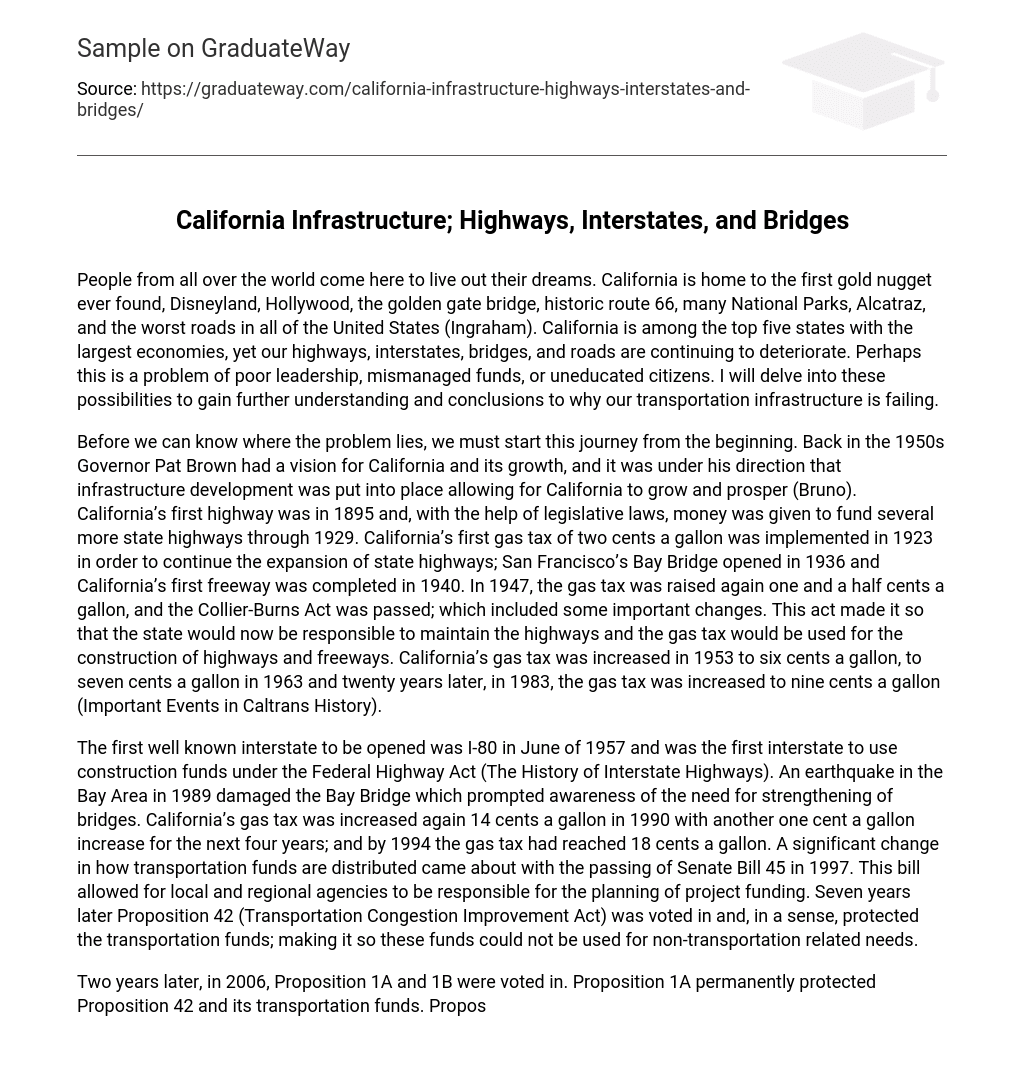People from all over the world come here to live out their dreams. California is home to the first gold nugget ever found, Disneyland, Hollywood, the golden gate bridge, historic route 66, many National Parks, Alcatraz, and the worst roads in all of the United States (Ingraham). California is among the top five states with the largest economies, yet our highways, interstates, bridges, and roads are continuing to deteriorate. Perhaps this is a problem of poor leadership, mismanaged funds, or uneducated citizens. I will delve into these possibilities to gain further understanding and conclusions to why our transportation infrastructure is failing.
Before we can know where the problem lies, we must start this journey from the beginning. Back in the 1950s Governor Pat Brown had a vision for California and its growth, and it was under his direction that infrastructure development was put into place allowing for California to grow and prosper (Bruno). California’s first highway was in 1895 and, with the help of legislative laws, money was given to fund several more state highways through 1929. California’s first gas tax of two cents a gallon was implemented in 1923 in order to continue the expansion of state highways; San Francisco’s Bay Bridge opened in 1936 and California’s first freeway was completed in 1940. In 1947, the gas tax was raised again one and a half cents a gallon, and the Collier-Burns Act was passed; which included some important changes. This act made it so that the state would now be responsible to maintain the highways and the gas tax would be used for the construction of highways and freeways. California’s gas tax was increased in 1953 to six cents a gallon, to seven cents a gallon in 1963 and twenty years later, in 1983, the gas tax was increased to nine cents a gallon (Important Events in Caltrans History).
The first well known interstate to be opened was I-80 in June of 1957 and was the first interstate to use construction funds under the Federal Highway Act (The History of Interstate Highways). An earthquake in the Bay Area in 1989 damaged the Bay Bridge which prompted awareness of the need for strengthening of bridges. California’s gas tax was increased again 14 cents a gallon in 1990 with another one cent a gallon increase for the next four years; and by 1994 the gas tax had reached 18 cents a gallon. A significant change in how transportation funds are distributed came about with the passing of Senate Bill 45 in 1997. This bill allowed for local and regional agencies to be responsible for the planning of project funding. Seven years later Proposition 42 (Transportation Congestion Improvement Act) was voted in and, in a sense, protected the transportation funds; making it so these funds could not be used for non-transportation related needs.
Two years later, in 2006, Proposition 1A and 1B were voted in. Proposition 1A permanently protected Proposition 42 and its transportation funds. Proposition 1B authorized the sale of $19.9 billion in bonds for transportation projects. A year later, for the first time in history $10 billion worth of construction on the highway system was overseen by Caltrans. California was given an Economic Stimulus Package; known as the American Recovery and Reinvestment Act in 2009 worth $3.64 billion. The most recent event in this history happened just last year on April 28, 2017 when Governor Brown proposed Senate Bill 1 which will close a funding gap for basic maintenance and the upkeep of California’s infrastructure, with an investment of $5.2 billion per year (Important Events in Caltrans History).
California’s population doubled between 1950 and 1970 as well as California’s GDP, yet the infrastructure development stopped and only maintenance occurred (Bruno). A few reasons for this was new Governor Jerry Brown’s mentality that small was better; going against his father’s vision and believing if no infrastructure was built people wouldn’t come here. Secondly, the passing of Proposition 13, and lastly, the term limits. Proposition 13 (passed in 1978) reduced property taxes by 57% and also included that “any measure enacted for the purpose of increasing state revenues to be approved by a two thirds vote of each house of the legislature” as well as “requiring taxes raised by local governments for a designated or special purpose to be approved by two-thirds of the voters” (What is Proposition 13). California’s term limits began in the 1990s.





